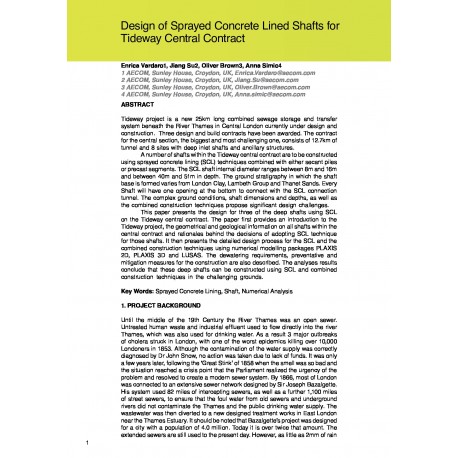Cart
0
0
No document
0,00 €
Total
Document successfully added to your shopping cart
Quantity
Total
There are 0 items in your cart.
There is 1 item in your cart.
Total documents
Total shipping
To be determined
Total
Search & filter
Search for a publication
Search & filter
Viewed documents
Design of Sprayed Concrete Lined Shafts for Tideway Central Contract
1012_design_of_sprayed_concrete_
J. Su / E. Vardaro / O. Brown / A. Simic
Tideway project is a new 25km long combined sewage storage and transfer system beneath the River Thames in Central London currently under design and construction. Three design and build contracts have been awarded. The contract for the central section, the biggest and most challenging one, consists of 12.7km of tunnel and 8 sites with deep inlet shafts and ancillary structures. A number of shafts within the Tideway central contract are to be constructed using sprayed concrete lining (SCL) techniques combined with either secant piles or precast segments. The SCL shaft internal diameter ranges between 8m and 16m and between 40m and 51m in depth. The ground stratigraphy in which the shaft base is formed varies from London Clay, Lambeth Group and Thanet Sands. Every Shaft will have one opening at the bottom to connect with the SCL connection tunnel. The complex ground conditions, shaft dimensions and depths, as well as the combined construction techniques propose significant design challenges. This paper presents the design for three of the deep shafts using SCL on the Tideway central contract. The paper first provides an introduction to the Tideway project, the geometrical and geological information on all shafts within the central contract and rationales behind the decisions of adopting SCL technique for those shafts. It then presents the detailed design process for the SCL and the combined construction techniques using numerical modelling packages PLAXIS 2D, PLAXIS 3D and LUSAS. The dewatering requirements, preventative and mitigation measures for the construction are also described. The analyses results conclude that these deep shafts can be constructed using SCL and combined construction techniques in the challenging grounds. Sprayed Concrete Lining, Shaft, Numerical AnalysisUntil the middle of the 19th Century the River Thames was an open sewer. Untreated human waste and industrial effluent used to flow directly into the river Thames, which was also used for drinking water. As a result 3 major outbreaks of cholera struck in London, with one of the worst epidemics killing over 10,000 Londoners in 1853. Although the contamination of the water supply was correctly diagnosed by Dr John Snow, no action was taken due to lack of funds. It was only a few years later, following the ‘Great Stink’ of 1858 when the smell was so bad and the situation reached a crisis point that the Parliament realized the urgency of the problem and resolved to create a modern sewer system. By 1866, most of London was connected to an extensive sewer network designed by Sir Joseph Bazalgette. His system used 82 miles of intercepting sewers, as well as a further 1,100 miles of street sewers, to ensure that the foul water from old sewers and underground rivers did not contaminate the Thames and the public drinking water supply. The wastewater was then diverted to a new designed treatment works in East London near the Thames Estuary.




